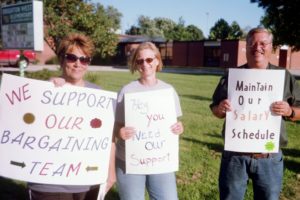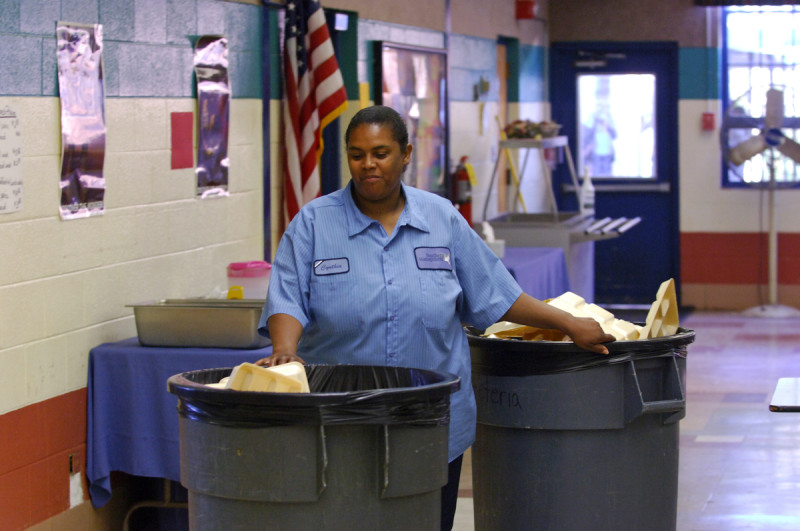Jeanne Middleton has lived in Brighton, Illinois, for 22 years. For the last seven, she has worked with Southwestern Community Unit School District Number 9 as a bus driver, lunchroom monitor, and utility worker – all at once. Combined, the jobs provide Middleton with enough work hours to qualify her for health insurance and other benefits.
“It’s challenging,” says Middleton, president of the Southwestern Education Support Professionals Association (SWESPA). “You get use to switching from one setting to the next.”
Like so many ESPs in the district, Middleton lives, shops, votes, and worships in the same school district where she works. She spends time with neighbors whose children are among those she drives to and from school.
 SWESPA members protest the possible loss of their salary schedule during contract negotiations. An October 5 tentative agreement maintains the schedule with its step increases.
SWESPA members protest the possible loss of their salary schedule during contract negotiations. An October 5 tentative agreement maintains the schedule with its step increases.
“I graduated from Alton High School about 15 miles from where we live now,” she says.
Many of SWESPA’s 60 members are also homegrown. They either attended the schools where they now work, have children attending these schools, or have a spouse who was born and raised in this rural farming community. They are rooted.
In school districts across the country, more than 70 percent of ESPs live in the same district where they work. Yet, superintendents and board members nationwide view ESPs like Middleton as expendable. Since June, SWESPA ESPs had been working on an expired contract.
After meeting throughout the summer, once under the supervision of a federal mediator, SWESPA members overwhelmingly rejected a school district proposal for a two-year contract that would abolish the salary schedule for non-certified employees.
“It was a slap in the face,” Middleton says. “The salary schedule helps ESPs plan their financial futures and encourages them to continue working with the district.”
After an October 5 bargaining session that went deep into the night, a tentative agreement was reached. It maintains the salary schedule and includes a 5 percent salary increase over two years and longevity step increase each year.
“Members understood that eliminating their negotiated salary schedule would have resulted in decreasing pay over their entire careers,” says Marcus Albrecht, the region’s UniServ Director with the Illinois Education Association (IEA). “This settlement demonstrates members’ voices matter.”
As with most salary schedules, SWESPA’s is based on a step system taking into account the number of years an employee has worked for the district. Before the settlement, district officials proposed a flat 3 percent raise in year one and 2.5 percent raise in year two. In the district, the entry-level wage is $10.50–$11.50 per hour. After 10 years, employees earn about $14.50 per hour. It takes employees 18 years to reach the highest step or maximum hourly salary of $18–$20 per hour.
Dismantling salary schedules, which appears to be a tactic being considered by more and more school district officials nationwide, represents a sea change in how educators are compensated.
“Abolishing the salary schedule is a new employer strategy,” Albrecht says. “It has the immediate effect of eliminating step compensation.”
Salary step schedules establish a judicious compensation system that provides an increased hourly wage for years of service to the district. This holds true in Southwestern district 9 as well as across the nation, according to Carolyn York, Director of Collective Bargaining and Member Advocacy for the National Education Association (NEA).
“Salary schedules that provide step increases remove subjectivity and bias from compensation decisions and guarantee equal treatment of all employees irrespective of their age, race, gender, religion, popularity, or union activism,” she says. “Salary schedules are objective, predictable, transparent, fiscally prudent, and help ensure that children have a stable, well-trained workforce educating them.”
While many school trustees judge salary schedules on merit, some antagonists harbor anti-union, anti-public educator agendas, says York.
“In some parts of the country, district officials have made abolishing the salary schedule a priority,” she says.
For example, on October 1, members of IEA’s McHenry Community High School Educators’ Association went on strike over, among other items, an education board attempting to dismantle their salary schedule. While some workers themselves push for modifying their salary schedule to emphasize professional growth, one disadvantage to the salary schedule is that low starting wages can cause some workers to live in poverty.
“In some cases, it requires too many years of service before an employee can reach top professional pay,” York says. “This is especially true for ESPs who may work a decade or longer in a school district before they earn a living wage.”
For the past three years, Southwestern district 9 non-classified employees did not receive a step increase in pay. Instead, they were granted a flat 2 percent raise.
“This is typical of how so many districts unfairly and unnecessarily target ESP jobs and wages during a financial struggle,” Albrecht adds. “They try to muscle ESPs for concessions even when there are sufficient funds in the budget.”
Most of the district’s 1,600 students (preK—12) live in the small towns of Brighton, Medora, Piasa and Shipman. Rebecca Buttitta is a secretary with the district’s transportation department and treasurer of IEA Region 5. It contains 37 locals including SWESPA, whose members are deeply steeped in the community.
“These are the people who volunteer with the Girl Scouts, shop at Tom’s Supermarket and the Dollar Store, and buy gasoline at Casey’s,” says Buttitta, a member of the SWESPA bargaining team. “They are the backbone of the community.”
Amid the cornfields and pastures in these towns are long stretches of highway. For some bus drivers this means 100-mile days of rolling out by 6:45 a.m. They face 50 miles of road ahead and as many students to pick up and return to school by first bell. In the afternoon, they do it again in the opposite direction. Afterwards, some drivers rest up, refuel, and prepare to carry another group of students to another distant location.
“In the evening, they sometimes have to drive the volleyball, basketball or baseball team another 50 miles each way to play a game,” Buttitta says. “They are a pretty dedicated group.”
At the schools, custodians polish the floors to perfection, paraeducators work one on one with students, and food service workers can be seen “sprinting from one end of the kitchen to the other trying to get kids their hot meals and fed on time,” Buttitta explains. “The money was there to pay these workers. They weren’t asking for the moon.”








